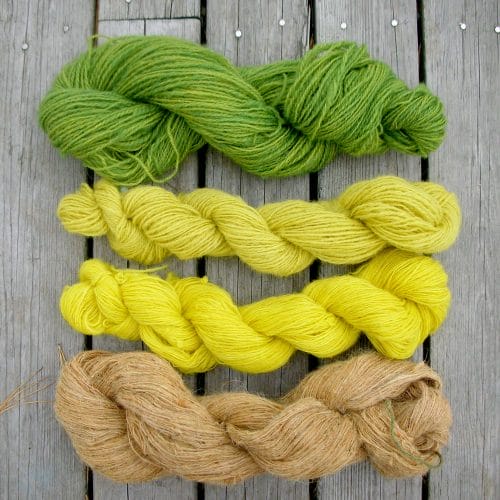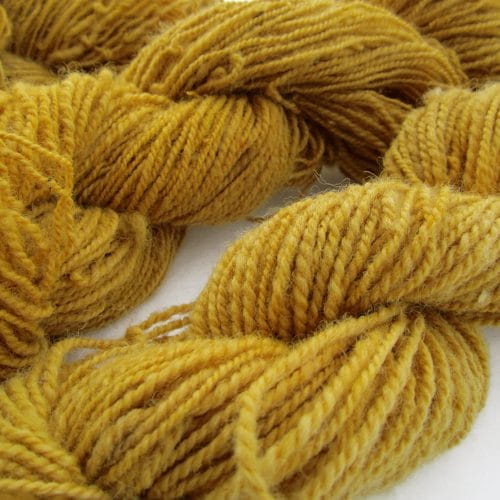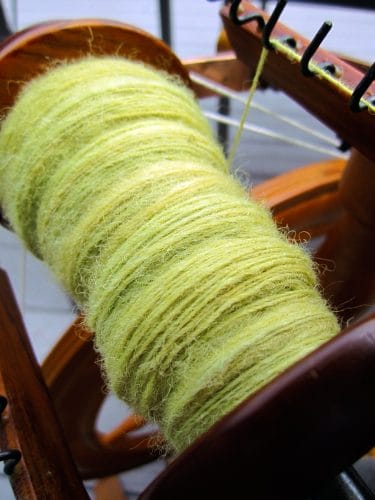The idea that a simple walk down the street or through a park can take you past a dozen different plants able to color your yarn in a stunning range of shades has piqued my interest since I was gifted a guide to natural dyes two years ago. Since then I have tried onions, indigo, coreopsis, goldenrod and scotch broom to dye my handspun.
The basic idea is to first, mordant your wool. I use alum because it’s fairly safe and won’t dull the colors. Then gather your plants. I use equal amounts of dye plants to wool I want to dye, so four ounces wool means I should gather at least 4 ounces dye material. Boil the plant until it looks like all of the color that will come out, has. Strain your new “dye tea”, making sure to remove all the plant matter. Gently submerge your skein(s) in the dye bath and maintain it at a hot but not boiling temperature for several hours or until your skeins stop absorbing color from the liquid. Ideally there should be very little to no pigment left in the water. Turn off the heat and let the bath cool for several hours or overnight. Remove your skeins and rinse in cool water until the excess pigment is washed out (and the water runs clear). Dip the skeins in a water + vinegar bath to set the color, rinse once more and hang to dry! Easy peasy. It just takes very little actual work, just some time.

From top to bottom: Wool dyed with Goldenrod (Solidago) overdyed with Indigo (Indigofera Tinctoria), Goldenrod leaves, Goldenrod flowers, and some half-heartedly washed llama dyed with Coreopsis flowers (Coreopsis Tinctoria). All four skeins were mordanted with alum.

Unmordanted wool dyed with yellow onion skins.

Wool roving dyed with the leaves and flowers from Scotch Broom (Cytisus Scoparius) and then handspun.
The simple act of gathering these plants from the yard, along the road
and hillsides gives me a sense of connection to the women who have come
before me to gather and process their own dyes from the wilds around
them. It feels good to be so earthy sometimes.
There are two books in our Knit Picks library (and available online) about natural dyes.
The first is a great book for beginning dyers: The Complete Guide to Natural Dyeing. The first half of this book focuses on pattern, color theory, basic
techniques to help streamline the whole process. I wish I’d had this one
when I started! The other pages feature large photos of dyed yarn, fabric and the plants used to make those dyes. It can be hard to capture the important identifying characteristics of a particular plant in one photograph but this book makes me feel confident that I can venture out into all that greenery and easily pick out what I need.
The second book is Harvesting Color. This book also has basic techniques for dyeing and information about various natural fibers. However, it also has a very extensive list of North American dye plants as well as extremely useful maps of North America to show you where the plant grows. This book would be the perfect addition to a beginning or experienced dyers library.
The information about where and how to find the plants I need as well as how to harvest them is by far the most useful and valuable part of this book. Field guides can tell you what a particular plant looks like but they don’t tell you about which season is best to gather them for dyeing or which parts to use. That’s where Harvesting Color comes in with plant specific information. I also like that this book focuses on plants that grow/are native to North America. Most books include Weld, Cochineal and other dyestuffs that are only available in other countries and can’t be foraged locally, although they do produce the most fantastic colors.


